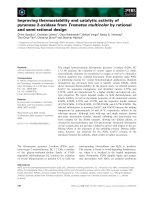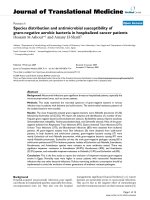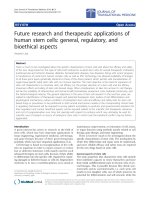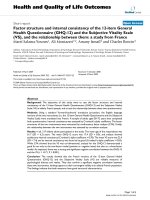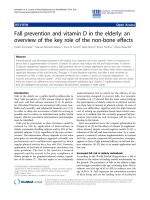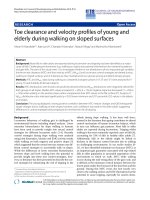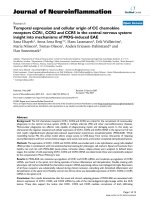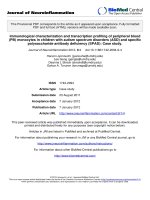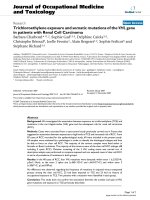Báo cáo hóa học: " Chemical composition and antibacterial activity of the essential oils from Launaea resedifolia L" pdf
Bạn đang xem bản rút gọn của tài liệu. Xem và tải ngay bản đầy đủ của tài liệu tại đây (165.78 KB, 4 trang )
ORIGINAL Open Access
Chemical composition and antibacterial activity
of the essential oils from Launaea resedifolia L
Amar Zellagui
1
, Noureddine Gherraf
1*
, Segni Ladjel
2
and Samir Hameurlaine
2
Abstract
Background: Several species of the genus Launaea are used in folk medicine such as in bitter stomachic, skin
diseases, and reported to have antitumor, insecticide, and cytotoxic activities. The antimicrobial activities of
coumarin constituents and the neuropharmacological properties have been investigated as well. In this study, the
chemical composition of essential oils from Launaea resedifolia L. has been identified using the ordinary GC-MS
technique to reveal the presence of 19 compounds dominated by dioctyl phthalate. Moreover, the antibacterial
activity of the crude oil has been carried out using disk diffusion method against seven bacteria strains.
Results: Nineteen compounds of essential oil of L. resedifolia L. were identified, representing 86.68% of the total oil.
The compo unds were identified by spectral comparison to be mainly esters, alcohols, ketones, and terpenes. The
principal constituents are dioctyl phthalate (39.84%), Decanoic acid, decyl ester (12.09%), 11-Octadecenal (11.24%),
and Eucalyptol (07.31 %), while others were present in relatively small amo unts. As far as antibacterial essays are
concerned, it was found that the oils are active against most of the tested bacterial strains.
Conclusion: A major constituent in visible parts was Dioctyl phthalate (39.84%) and the yield of essential oils was
0.9%. These extracts reveal in vitro antibacterial activity on the studied bacterial, confirmed by the inhibition zone
diameter ranging from 11 to 37 mm and a MIC value between 0.09 and 0.69 depending on the microorganism
being tested.
Keywords: chemical composition, antibacterial activity, essential oils, Launaea resedifolia
1. Background
The genus Launaea (Asteraceae) is represented in the
flora of Algeria by nine species, namely, Launaea
acanthoclada, Launaea angustifolia, Launaea anomala,
Launaea arborescens, Launaea cassiniana, Launaea glo-
merata, Launaea nudicaulis, Launaea quercifolia,and
Launaea resedifolia [1,2]. L. resedifolia (local name “laa-
did, Azim”) is a perennial herb widely distributed in the
arid regions of Mediterranean area, where it is abundant
in south east of Algeria.
Several species of this genus are used in folk medicine
in bitter stomachic, skin diseases, and reported to have
antitumor, insecticide and cytotoxic activities [3]. The
antimicrobial activities of coumarin consti tuents [4] and
the neuropharmacological properties [5] have been
investigated as well.
To the best of the authors’ knowledge, there are no
reports about the chemi cal content and biologi cal effect
of the essential oils of L. resedifolia. There no reports
on the essential oils of the species of the genus launaea
except that reported by Cheriti et al. [6]. In continuation
of our phytochemical and antibacterial studies of the
Algerian Sahara medicinal plants [7-11], we report here
the findings of our studies on the composition and anti-
microbial activity of L. resedifolia essential oils. The spe-
cies was collected during the flowering sta ge in south-
eastern Algeria (Ouargla) and identified by Dr. Abdel-
madjid Chahma, Biology Department, Ouargla Univer-
sity, Algeria. A voucher specimen was deposited at the
herbarium under the code NG 27.
2. Results and discussions
The aerial parts of L. resedifolia were collected in March
2010 in the outskirts of Ouargla (600 km south of
Algiers). The plant was identified by Dr. Abdelmadjid
* Correspondence:
1
Laboratory of Biomolecules and Plant Breeding, Life Science and Nature
Department, University of Larbi Ben Mhidi Oum El Bouaghi, Algeria
Full list of author information is available at the end of the article
Zellagui et al. Organic and Medicinal Chemistry Letters 2012, 2:2
/>© 2012 Zellagui et al; licensee Springer. This is an Open Access article distributed under the terms of the Creative Commons
Attribution License ( nses/by/2.0), which permits unres tricted use, distribution, and reproduction in
any medium, provided the original work is properly cited.
Chahma. A voucher specimen was deposited at the her-
barium under the number NG 27.
2.1 Isolation of essential oils
An aliquot of 200 g of the visible parts of L. resedifolia
was cut into pieces, air-dried under shade, and subjected
to hydrodistillation on a Clavenger-type a pparatus for 4
h. The distillate was then extracted using diethyl ether.
The resulting extract was dried on anhydrous sodium
sulphate. Diethyl ether was removed carefully and the
esse ntial oil was collected and stored at 4°C until analy-
sis. The oil yield was calculated relative to the dry
matter.
2.2 GC-MS analysis
The oil was analyzed by GC/MS using a Agilent 5973EI
mass selective detector coupled with an Agilent GC6890A
gas chromatograph, equipped with a cross linked 5% PH
ME siloxane HP-5MS capillary column (30 m × 0.25 mm,
film thickness 0.25 μm). Operating conditions were as fol-
lows: carrier gas, helium with a flow rate of 1 mL/min; col-
umn temperature 50°C for 1 min, 50-150°C (3°C/mn),
150-250°C (5°C/mn) then isothermal for 5 min.
Injector and detector temperatures: 280°C; split ratio,
1:50.
The MS operating parameters were as follows: i oniza-
tion potential, 70 eV; ionization current, 2 A; ion source
temperature, 200°C; resolution, 1000.
2.3 Identification of components
Identification of oil components was achieved on the
basis of their retention indices (RI) (determined with
reference to a homologous series of normal alkanes),
and by co mparison of their mass spectral fragmentation
patterns with those reported in the literature [12] and
stored on the MS l ibr ary (NIST database). The concen-
tration of the identified compounds was computed from
the GC peak total area without any correction factor.
2.4 Antibacterial activity
In recent years due to an upsurge in antibiotic-resistant
infections, the search for novel archetype prescriptions
to fight infections is an absolute necessity and in this
regard, plant essential oils may offer a great potential
and hope. Several studies have reported the efficacy of
antibacterials obtained from the essential oils of various
plant species [13-15]. In this study, antibacterial activity
of essential oil extracted from aerial parts of L. resedifo -
lia was tested using different bacterial strains: Escheri-
chia coli, Staphylococcus aureus, Staphylococcus
intermedius, Proteus mirabilis, Streptococcus pyogenes,
Pseudomonas aeruginosa,andKlebsielle pneumoniae.In
addition, the composition of volatile compounds was
also determined.
All bacterial samples were obtained from the bacter-
iology laboratory SAIDAL, Algeria. The antimicrobial
activity tests were carried out using disk diffusion
method [15] against seven human pathogenic bacteria,
including Gram positive a nd Gram-negative bacteria.
The bacteria strains were first grown on Muller Hinton
medium at 37°C for 24 h prior to seeding on to the
nutrient agar.
A sterile 6-mm diameter filter disk (W hatman paper
n
o
3) was placed on the infusion agar seeded with bac-
teria, and each extract suspended in water was dropped
on to each paper disk (40 μL per disk). The treated
Petri disks were kept at 4°C for 1 h, and incubated at
37°C for 24 h. The antibacterial activity was assessed by
measuring the zone of growth inhibition su rrounding
the disks. Each experiment was carried out in triplicate
[16].
The minimal inhibitory concentration (MIC) was
determined by dilution of the essential oil in dimethyl
sulphoxide (DMSO) pipetting 0.01 mL of each dilution
onto a filter paper disc [17,18]. Dilutions of the oil
within a concentration range of 10-420 g/mL were also
carried out. MIC was defined as the lowest concentra-
tion that inhibited the visible bacterial growth.
A negative control was also included in the test using
a filter paper d isk saturated with DMSO to check possi-
ble activity o f this solvent against the bacteria assayed.
The experiments were repeated three times.
2.5 Chemical composition
The compounds of aerial parts essential oil of L. resedi-
folia from Algeria are listed in order of th eir elution on
the HP-5MS non-polar column (Table 1). A total of 19
compounds were identified, representing 86.68% of the
total oil. The esters made up the largest component of
the oil including Dioctyl phthalate (39.84%), Decanoic
acid, decyl ester (12.09%) and (E)-2-Hepte noic acid,
ethyl ester (5.21%). Aldehydes represent the second lar-
gest group (11.45) involving 11-Octadecenal (11.24%)
and Heptanal (0.21%).
The monoterpenes represent a relatively low content
(8.95%) with eucalyptol as the major constituent
(7.31%). A better agreement was found between the oil
content of L. resedifolia and that of L. arboresens as was
reported by Cheriti et al. [6]. The slight difference may
be due to t he geographical location and the harvesting
period. It is noteworthy that the results o f this study
may be considered as the first report on the composi-
tion of the essential oils of this endemic species.
2.6 Antimicrobial activity
The quantification of antibacterial activity for L. resedi-
folia essential oils was measured by the agar disk diffu-
sion method. The effectiveness of the essential oil is
Zellagui et al. Organic and Medicinal Chemistry Letters 2012, 2:2
/>Page 2 of 4
demonstrated by the size of the microorganism growth
inhibition zone around the filter paper disk, which is
typically expressed as the diameter of the inhibition
zone in millimeter. Results obtained in the antibacterial
study are shown in Table 2. The results indicated that S.
aureus was the most sensitive strain to the oil of L. rese-
difolia with the strongest in hibition zone (37 mm) and a
MIC value of 0.09 mg/mL. The strains S. intermedius,
K. pneumoniae, S. pyogenes and P. mirabilis were found
to be fairly sensitive with inhibition zones of 29, 27, 23,
and 20 mm, respectively. Modest activities were
observed against E. coli and Pseudomonas aerugenosa
with inhibition zones of 15 and 12 mm. Against S. inter-
medius, K. pneumoniae, S. pyogenes, P. mirabilis, E. coli
and, P. aerugenosa, the oils showed MIC values of 0 .13,
0.21, 0.35, 0.47, 0.54, and 0.69 mg/mL, respectively.
3. Conclusions
The chemical analyses by GC/MS allowed the identifica-
tion of 86.68% of the total volatile products for L. resedi-
folia and 19 volatile compounds. A major constituent in
visible parts was Dioctyl phthalate (39.84%) and the
yield of essential oils was 0.9%. These extracts reveal in
vitro antibacterial activity on the studied bacterial, con-
fir med by the inh ibition zone diameter ranging from 11
to 37 mm and a MIC value between 0.09 and 0.69
depending on the microorganism being tested. Antibac-
terial activit ies of these essential oils were due to abun-
dance of overall chemical constituents. The antibacteria l
activity besides several biological activities can be used
in place of costly antibiotics for effective control of the
food pathogens.
Author details
1
Laboratory of Biomolecules and Plant Breeding, Life Science and Nature
Department, University of Larbi Ben Mhidi Oum El Bouaghi, Algeria
2
Kasdi
Merbah University, Ouargla, Algeria
Competing interests
The authors declare that they have no competing interests.
Received: 18 September 2011 Accepted: 20 January 2012
Published: 20 January 2012
References
1. Ozenda P (1983) Flore du Sahara. CNRS, Paris
2. Quezel P, Santa S (1963) Nouvelle flore d’Algérie et des régions désertique
méridionales. CNRS, Paris 2:162
3. Rashid S, Ashraf M, Bibi S, Anjum R (2000) Insecticidal and cytotoxic
activities of Launaea Nudicaulis (Roxb.) and Launaea Resedifolia (Linn.). Pak J
Biol Sci 3(5):808–809
4. Ashraf AE, Nabil AA (2006) Antibacterial coumarins isolated from Launaea
resedifolia. Chem Plant Raw Mater 1:65–68
5. Abdu Raazag A, Auzi , Najat T, Hawisa M, Sherif F, Atyajit D, Sarker (2007)
Neuropharmacological properties of Launaea resedifolia. Braz J
Phamacognosy 17(2):160–165
6. Cheriti A, Saad A, Belboukhari N, Ghezali S (2006) Chemical composition of
the essential oil of Launaea arboresens from Algerian Sahara. Chem Nat
Compounds 42(3):360–361. doi:10.1007/s10600-006-0123-5.
7. Kalla A, Gherraf N, Belkacemi D, Ladjel S, Zellagui A, Hameurelain S, Chihi S,
Labed B (2009) Composition of the essential oil of Rhanterium adpressum
Coss. and Durieu from Algeria. Arch Appl Sci Res 1(2):115–118
8. Gherraf N, Zellagui A, Mohamed NS, Hussien TA, Mohamed TA, Hegazy ME,
Rhouati S, Moustafa MF, El-Sayed MA, Mohamed Ael-H (2010) Triterpenes
from Euphorbia rigida . Pharmacognosy Res 2(3):159–162
9. Kalla A, Belkacemi D, Gherraf N, Zellagui A, Messai L, Ladjel S,
Hameurelaine S, Labed B, Chihi S (2010) Seasonal variability of essential oil
content of Pituranthos scoparius. Asian J Chem 22(4):3065–3068
10. Labed B, Gherraf N, Hameurlaine S, Ladjel S, Zellagui A (2010) The
antibacterial activity of water extracts of Traganum nudatum Del
(Chenopodiaceae) growing in Algeria. Der Pharmacia Lettre 2(6):142–145
Table 1 Chemical content of essential oils of L. resedifolia
L
Compound RT
(min)
Percentage
1 Pentanedioic acid, dimetyl ester 14.56 0.13
2 linalool 26.32 1.45
3 Eucalyptol 29.88 7.31
4 Hexadecanol 31.17 2.82
5 Octanol 32.05 0.87
6 a-Limonene diepoxide 32.13 0.19
7 (Z)-6-Octen-2-one 33.23 0.64
8 Heptanal 36.15 0.21
9 3,4-Dimethylcyclohexanol 36.61 0.13
10 bornyl acetate 36.83 0.19
11 caryophyllene oxide 37.68 1.04
12 1,2-Benzenedicarboxylic acid, butyl octyl
ester
38.37 0.22
13 Dibutylphthalate 45.51 2.93
14 (Z)-3-Dodecene, 50.38 0.17
15 Hexanedioic acid, dioctyl ester 56.52 Tr.
16 (E)-2-Heptenoic acid, ethyl ester, 60.98 5.21
17 Dioctyl phthalate 61.93 39.84
18 11-Octadecenal 66.81 11.24
19 Decanoic acid, decyl ester 72.39 12.09
Total 86.68
Esters 60.61
Aldehydes 11.45
Oxygene monoterpenes 8.95
Alcohols 03.82
Oxygene sesquiterpenes 1.04
Ketones 0.64
Alkenes 0.17
Table 2 Inhibition zone diameter (mm)
Microorganisms Disc diffusion assay (inhibition zone
mm)
MIC (mg/
mL)
S. aureus 37 0.09
S. intermedius 29 0.13
K. pneumoniae 27 0.21
S. pyogenes 23 0.35
P. mirabilis 20 0.47
E. coli 15 0.54
P. aerugenosa 12 0.69
Zellagui et al. Organic and Medicinal Chemistry Letters 2012, 2:2
/>Page 3 of 4
11. Kendour Z, Ladjel S, Gherraf N, Ouahrani MR (2010) Antimicrobial activity of
nine medicinal plants growing in the south of Algeria. Ann Biol Res
1(4):145–147
12. Adams RP (2007) Identification of essential oil components by Gas
chromatography/mass spectrometry. Allured Publishing Corporation, Carol
Stream, 4
13. Mouhssen L (2001) Methods to study the photochemistry and bioactivity of
essential oils. Phytother Res 18:435–448
14. Saet Byoul Lee., et al (2007) The antimicrobial activity of essential oil from
Dracocephalum foetidum against pathogenic microorganisms. J Microbiol
45(1):53–57
15. Derwich E, Benziane Z, Abdellatif B (2010) GC:MS analysis and antibacterial
activity of the essential oil of Mentha. Pulegium grown in Morocco. Res J
Agric Biol Sci 6(3):191–198
16. Bauer AW, Kirby WMM, Sherris JC, Turck M (1966) Antibiotic susceptibility
testing by a standardized single disk method. Am J Clin Pathol 45:493–496
17. Iscan G, Demirci F, Kirimer N (2002) Antimicrobial screening: Mentha
piperita essential oil. J Agric Food Chem 50:3943–3946. doi:10.1021/
jf011476k.
18. Demirci F, Guven K, Demirci B, Dadandi MY, Baser KHC (2008) Antibacterial
activity of two Phlomis essential oils against food pathogens. Food Control
19:1159–1164. doi:10.1016/j.foodcont.2008.01.001.
doi:10.1186/2191-2858-2-2
Cite this article as: Zellagui et al.: Chemical composition and
antibacterial activity of the essential oils from Launaea resedifolia L.
Organic and Medicinal Chemistry Letters 2012 2:2.
Submit your manuscript to a
journal and benefi t from:
7 Convenient online submission
7 Rigorous peer review
7 Immediate publication on acceptance
7 Open access: articles freely available online
7 High visibility within the fi eld
7 Retaining the copyright to your article
Submit your next manuscript at 7 springeropen.com
Zellagui et al. Organic and Medicinal Chemistry Letters 2012, 2:2
/>Page 4 of 4
